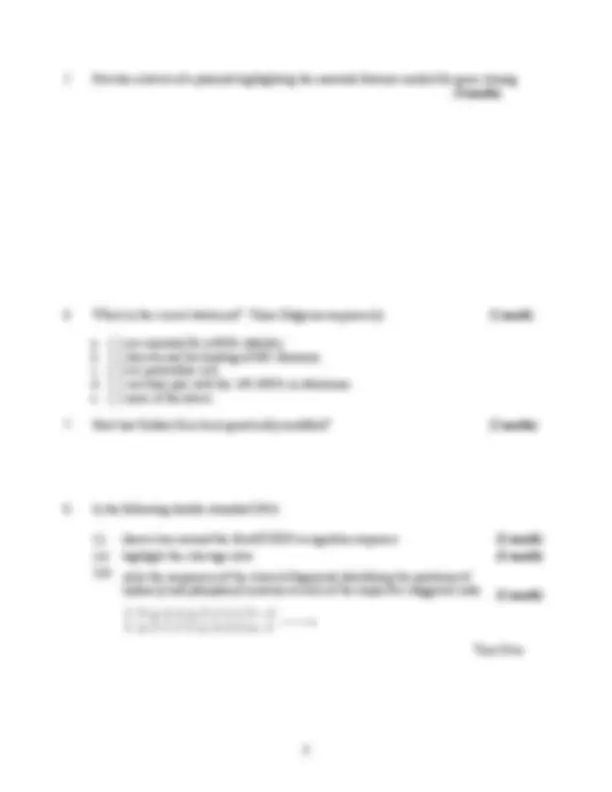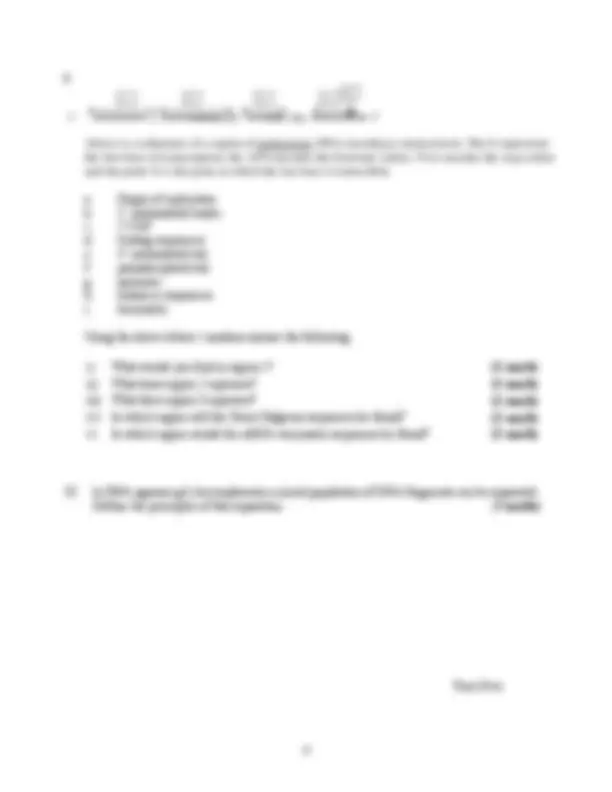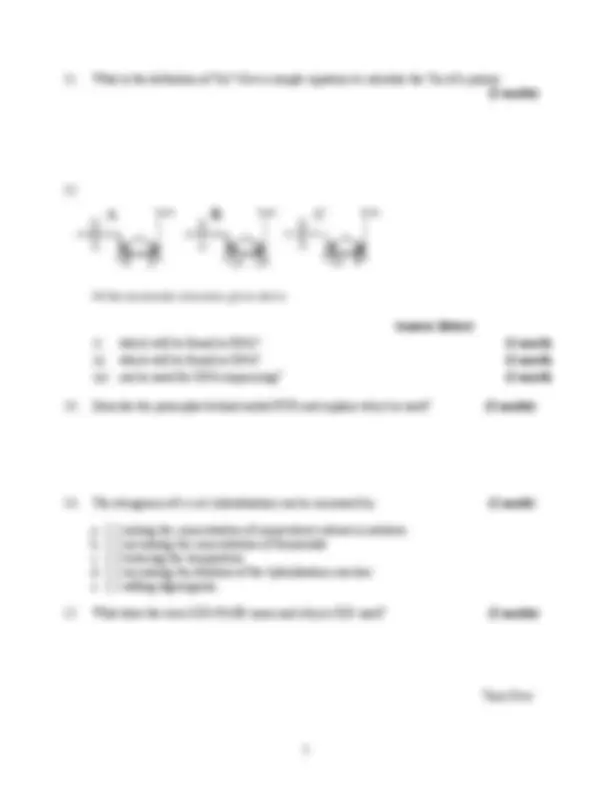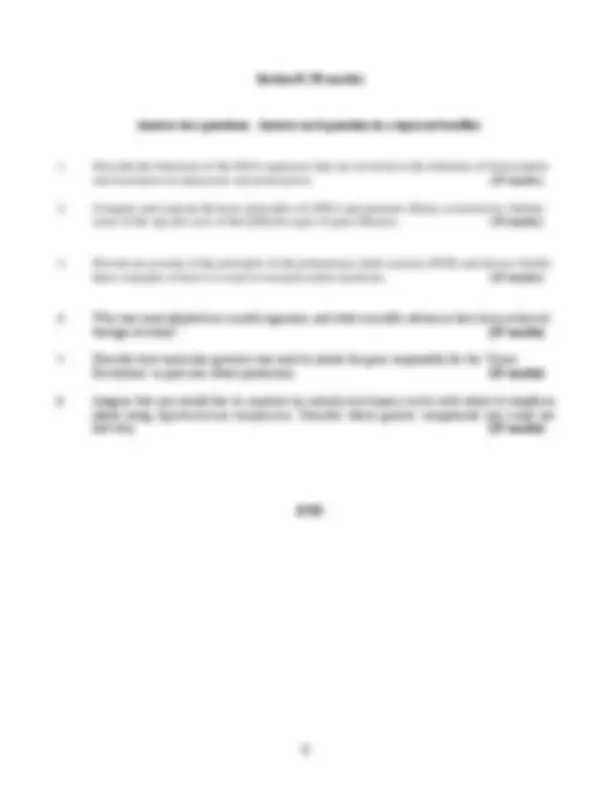






Study with the several resources on Docsity

Earn points by helping other students or get them with a premium plan


Prepare for your exams
Study with the several resources on Docsity

Earn points to download
Earn points by helping other students or get them with a premium plan
Community
Ask the community for help and clear up your study doubts
Discover the best universities in your country according to Docsity users
Free resources
Download our free guides on studying techniques, anxiety management strategies, and thesis advice from Docsity tutors
Plant Transformation Technique, Region of Prokaryotic Dna, Origin of Replication, Coding Sequences, Polyadenylated Tail, Enhancer Sequences, Agarose Gel Electrophoresis, Population of DNA, Definition of TM are some points from questions of Applied Molecular Biology subject.
Typology: Exams
1 / 8

This page cannot be seen from the preview
Don't miss anything!





Time allowed — 3 hours
Read these instructions carefully:
This question paper thus becomes the answer book for Section A and it must be handed in complete. Make sure your name is on it and your reference/identification number.
Section A (50 marks) Answer all questions. Tick the appropriate box where necessary, e.g [ ]
a. [ ] They catalyse the synthesis of DNA in the 5'-3' direction. b. [ ] They require a primer for synthesis to proceed. c. [ ] They do not require a primer for synthesis to proceed. d. [ ] Some DNA polymerases have exonuclease activity. e. [ ] DNA polymerases have no role in transcription.
a. [ ] Biolistic bombardment. b. [ ] Polyethylene glycol-mediated protoplast fusion. c. [ ] Microinjection. d. [ ] Agrobacterium- mediated. e. [ ] Electroporation of protoplasts.
a. [ ] an antisense gene for polygalacturonase b. [ ] a gene conferring resistance to the herbicide glyphosate c. [ ] a gene which produces Bt toxin d. [ ] a viral coat protein gene e. [ ] a gene to enhance ripening.
i) What function does this enzyme have in relation to the lac operon? (1 mark )
ii) What is the name of the colourless substrate it can hydrolyse to form a blue product? (^) (1 mark)
Turn Over
Above is a schematic of a region of prokaryotic DNA encoding a monocistron. The G represents the first base of transcription, the ATG encodes the first/start codon, TAA encodes the stop codon and the point X is the point at which the last base is transcribed.
a. Origin of replication b. 5’ untranslated leader c. 5' CAP d. Coding sequences e. 3’ untranslated tail f. polyadenylated tail g. promoter h. enhancer sequences i. terminator
Using the above letters / numbers answer the following.
i) What would you find in region 1? (1 mark) ii) What does region 2 represent? (1 mark) iii) What does region 3 represent? (^) (1 mark) iv) In which region will the Shine Dalgarno sequences be found? (^) (1 mark) v) In which region would the mRNA terminator sequences be found? (1 mark)
Turn Over
Of the nucleotide structures given above
Answer (letter) i) which will be found in RNA? (1 mark) ii) which will be found in DNA? (1 mark) iii) can be used for DNA sequencing? (1 mark)
a. [ ] raising the concentration of monovalent cations in solution b. [ ] increasing the concentration of formamide c. [ ] lowering the temperature d. [ ] increasing the duration of the hybridisation reaction e. [ ] adding digoxigenin.
Turn Over
Wheat is a [diploid][hexaploid] crop plant, whose height has been [enhanced][reduced] by post- war breeding programmes, using gibberellin [biosynthesis][insensitivity] mutant genes that have been cloned by [transposon tagging][polymerase chain reaction].
a. [ ] the genetic variation occurring in cells following prolonged periods of culture b. [ ] the genetic variation seen within individual cells of a plant c. [ ] essential for somatic embryogenesis d. [ ] suppressed by high levels of auxin e. [ ] an unavoidable consequence of plant tissue culture.
a. [ ] tmr. b. [ ] Vir operon. c. [ ] tms1. d. [ ] right border. e. [ ] tryptophan mono-oxygenase.
Turn over
Section B ( 50 marks)
Answer two questions. Answer each question in a separate booklet.